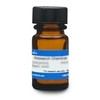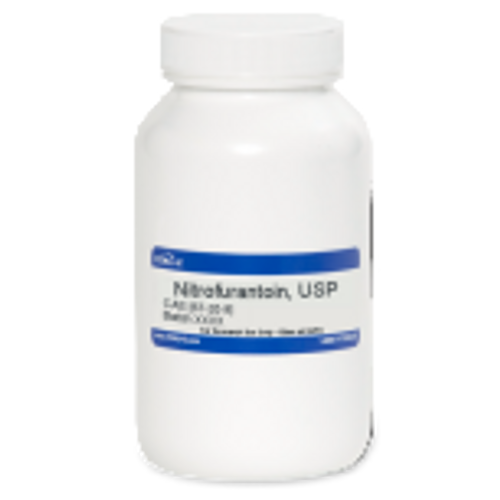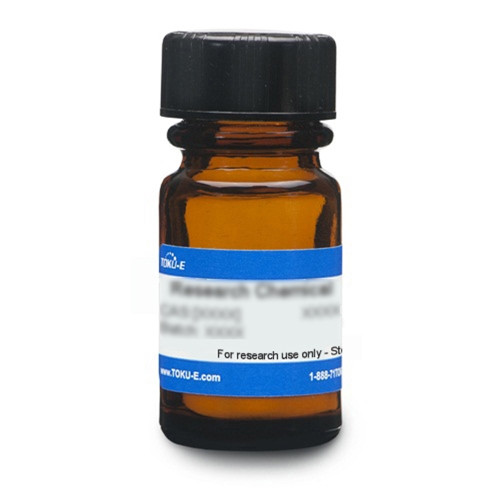Nitrofurantoin Monohydrate is broad-spectrum nitrofuran antibiotic that is a synthetic derivative of imidazolidinedione (hydantoinused as a substrate for bacterial glycoprotein nitrofuran reductase). It is bacteriostatic against Gram-positive and Gram-negative bacteria due to its unique hydantoin ring with a nitro-substituted furanyl side chain that is metabolized within the bacteria to produce reactive compounds that are bactericidal. Nitrofurantoin has anti-cancer properties against bladder cancer cells grown in vitro. The compound can be used to study antibiotic resistance.
Nitrofurantoin Monohydrate is soluble in DMF, very slightly soluble in ethanal, and practically insoluble in water.
| Mechanism of Action |
Nitrofurantoin has a unique mode of action in that it does not require growth or active metabolism to exert its effect. In vitro, it acts as a mutagen by inhibiting DNA synthetase. Upon entering a susceptible cell, Nitrofurantoin is activated by bacterial enzyme and flavoprotein (nitrofuran reductase) to unstable metabolites which then target ribosomes and nucleic acids which leads to inhibition of bacterial growth and death of the bacterial cells due to the inactivation of of protein synthesis, DNA and RNA synthesis and cell wall synthesis. Resistance to Nitrofurantoin may be chromosomal or plasmid-mediated. If chromosomal, it is due to reduced activity of nitrofurantoin reductase. |
| Spectrum | Nitrofurantoin is a broad-spectrum antibiotic with bacteriostatic activity against Gram-positive and Gram-negative bacteria. It is active against the bacteria causing urinary tract infections. Nitrofurantoin has been found to be effective against certain β-lactam resistant strains of VRE or vancomycin resistant Enterococcus; a glycopeptide antibiotic resistant "superbug." Nitrofurantion is also used against Enterococci, Staphylococci, Streptococci, Corneybacteria, and E. coli. Most strains of Proteus spp. and Pseudomonas aeurginosa are naturally resistant to Nitrofurantoin. |
| Microbiology Applications | Nitrofurantoin is commonly used in clinical in vitro microbiological antimicrobial susceptibility tests (panels, discs, and MIC strips) against Gram-positive and Gram-negative microbial isolates. Medical microbiologists use AST results to recommend antibiotic treatment options. Quantitative methods for MIC determination using a dilution mtethod (broth or agar). Representative MIC values include:
E. coli 32 µg/mL - 64 µg/mL
Nitrofurantoin can be used against Lysteria monocytogenes-persisters in vitro, and was effective against both growing and dormant cells (Knudsen et al, 2013). In general, organisms are said to be susceptibile if the MIC is ≤ 32 µg/ml. The activity of this compound is pH- dependent, and the mean MIC rises sharply with pH >6. |
| Eukaryotic Cell Culture Applications | Nitrofuranton is toxic to human WI-38 fibroblasts in culture and antioxidants can mitigate effect. On a molecular basis, glutathione peroxidase was the most efficient at protection (Michiels and Remacle, 1988). Nitrofurantoin can alter the morphology, viability, and phagocytic activity of bovine mammary polymorphonuclear leukocytes in vitro, when added at 1 mg/ml (Nickerson et al, 1995). |
| Molecular Formula | C8H6N4O5 . H2O |
| References |
Fitzpatrick PM and Charles C. McOsker CM (1994) Nitrofurantoin: Mechanism of action and implications for resistance development in common uropathogens. J. Antimicrob. Chemother. 33(Suppl A):23-30 PMID 7928834 Kamat AM ad Lamm DL (2004) Antitumor activity of common antibiotics against superficial bladder cancer. Urol. 63(3):457-460 PMID 15028437 Knudsen GM, Ng Y and Gram L (2013) Survival of bactericidal antibiotic treatment by a persister subpopulation of Listeria monocytogenes. App. Environ. Microbiol. 79(23):7390-7397 PMID 24056460 Michiels C and Remacle J (1988) Quantitative study of natural antioxidant systems for cellular Nitrofurantoin toxicity. Biochim. Biophys. Acta 967(3):341-347 PMID 3196753 Nickerson SC, Paape MJ, Dulin AM (1985) Effect of antibiotics and vehicles on bovine mammary polymorphonuclear leukocyte morphologic features, viability, and phagocytic activity in vitro. Am J Vet Res. 46(11):2259-2265 PMID 4073636 |







